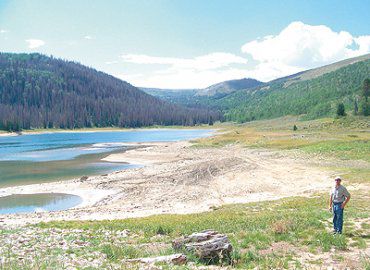“Water is the lifeblood of Emery County.” We who live and work in the semi-arid climate of Southeastern Utah understand this statement as only we can. It seems all other functions in this part of our world are contingent on our water resource and its availability. With this understanding, the water-use subcommittee of the Emery County Public Lands Council determined to take on the task of evaluating this precious resource and identify areas where improvements to current water management might be possible.
The water-use subcommittee hosted a San Rafael River/Muddy Creek Watershed Study kick-off meeting on Aug. 26. Partners of the subcommittee, including personnel from Utah Division of Water Resources, Natural Resources Conservation Service, Emery Water Conservancy District, Utah Division of Wildlife Resources, Muddy Creek Irrigation Company, Ferron Creek Canal and Reservoir Company, Cotton Creek Irrigation Company and Huntington/Cleveland Irrigation Company met at the Castle Valley Lodge in Moore to first discuss the following field tour and hear some remarks from Norm Evenstad and Todd Stonely of NRCS and a presentation of native fish issues by Paul Birdseye of DWR.
The study these partners are undertaking is intended to accomplish several objectives, some of which are: Complete thorough analysis of both the San Rafael River and Muddy Creek watersheds to detail the hydrologic function of each watershed. The study would also create a water budget, identify existing water supplies, any discernable trends, and quantify the amount of water that could potentially be captured before it flows out of the system.
Identify all existing developed water supplies and uses within both watersheds, and estimate future water supplies and demands.
Consider automation, remote control and monitoring of water delivery systems to increase efficiency.
Explore the possibility of increased storage capacity within the study areas.
Summarize the existing wildlife habitat and needs. The San Rafael River is home to three federally listed endangered fish and four state listed sensitive species. Potential actions required to preserve and improve these important values would be evaluated.
The estimated budget of the project approaches $300,000 and will be a combination of congressionally earmarked funds, Community Impact Board dollars, industry participation and a variety of local matching funds.
Following the overview meeting at Castle Valley Lodge, the participants mobilized to a tour of portions of the watersheds and current projects and water storage facilities. The first stop was the de-siltation structure project on Muddy Creek. This project will remove silt and debris from the creek and deliver it to the existing canal system for transportation to the town of Emery. According to Emery Mayor and sub-committee co-chairperson Mistie Christiansen, the de-siltation structure is an $800,000 project and is about 70 percent complete. The town is currently attempting to develop funding to install a pipeline to get the de-silted water from the new structure to the town’s water treatment plant. The Mayor is hopeful that this study and other resources will be helpful in demonstrating the viability of the pipeline.
From the parking lot of the Millsite State Park, Norm Evenstad gave an explanation of the current efforts by most of these same participants to develop a strategy for Millsite Dam which will develop a new emergency spillway, capable of accommodating catastrophic flows, and probably raise the height of the dam by four feet to offset the loss of storage capacity due to siltation from Ferron Creek. A dredge and slurry system, intended to route incoming silt past the reservoir and flush it on down stream is also being considered at Millsite.
After the group reassembled at the nearly completed diversion system on Huntington Creek, Cody Allred, Huntington Cleveland Irrigation Company member and Rocky Mountain Power Representative briefly explained the function of the new system. HCIC had been fortunate to have this project funded mostly by America’s Reinvestment and Recovery Act, also known as stimulus funding. The structure is designed to receive raw water from Huntington River, eliminate debris with a system of revolving screens, and deliver the water to two large pipelines that in turn move the water to farms and irrigation systems in the North Emery area. According to Allred, some problems have been encountered with the screening system but the manufacturer is working with the irrigation company to get them resolved and the system functioning properly.
To complete a full day and give the visitors from out of the area a better understanding of the beginning stages of water management in Emery County, the group traveled up Huntington Canyon and made observations of on-the-ground conditions of the high-country watershed and storage facilities. The entourage traveled past Electric Lake, and made stops at Cleveland, Rolfson and Miller’s Flat Reservoirs.
Water: lifeblood of county

"Cody Allred stands beside a depleted Rolfston Reservoir."
